Text
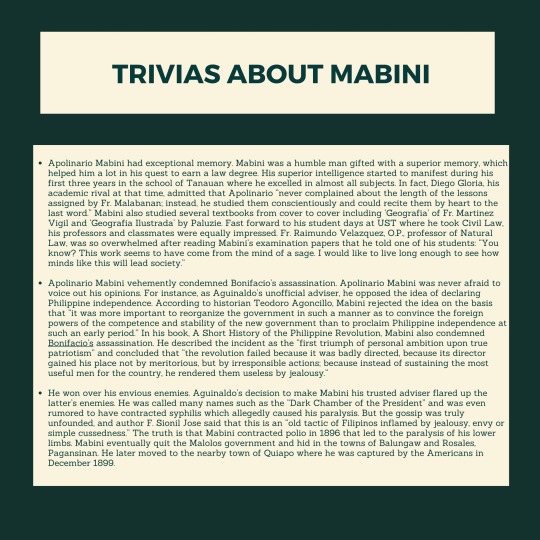
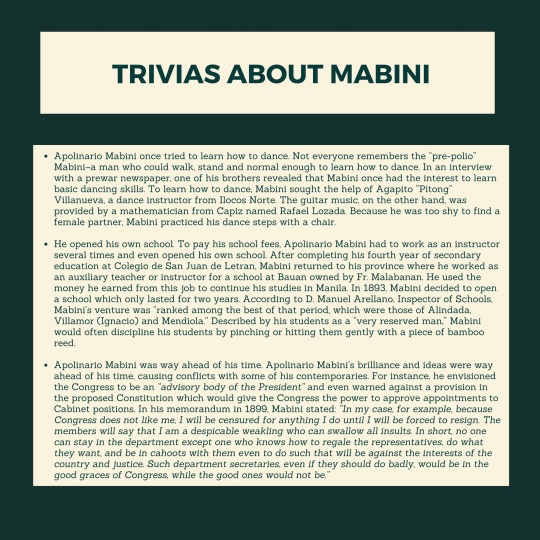
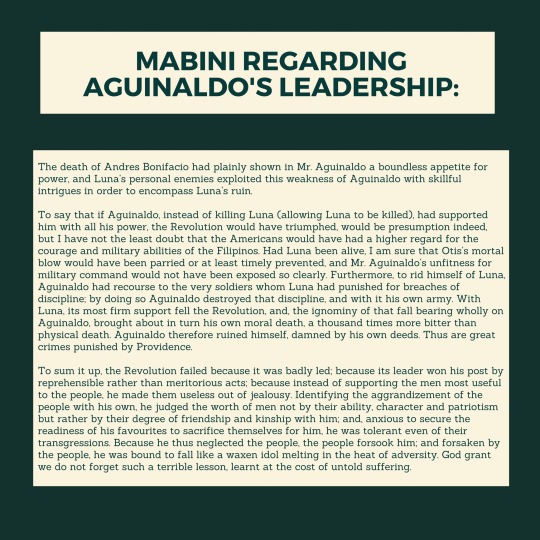
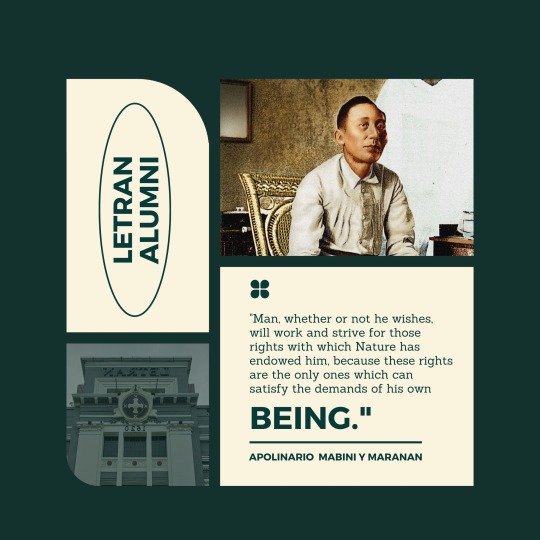
Apolinario Mabini, the stellar individual who was also called as the Brains and Conscience of the Philippine Revolution. Known for his extraordinary intellect, political prowess, and rhetoric, Mabini's efforts and ideas on governance impacted the Philippines' fight for independence throughout the following century, despite his tragic death in 1903. Mabini was born into a peasant family and attended Colegio de San Juan de Letran College in Manila before graduating with a law degree from the University of Santo Tomás in 1894. In August 1896, during a nationalist insurgency, he joined the armies of General Emilio Aguinaldo and frequently became his right-hand man. When the Spanish-American War began in 1898, Mabini proposed an alliance with the United States as a method to gain independence from Spain. Mabini was able to address Aguinaldo from the Philippines, who governed as an autocrat, on July 23, 1898. He compelled the new president to establish a revolutionary administration based on a convention rather than a dictatorship. An independent republic was declared with Aguinaldo as its president during a convention conducted in the market town of Malolos in September and October 1898; Mabini drafted its constitution, which paralleled that of the United States. When the US decided to conquer the Philippines, Mabini joined Aguinaldo in renewing the battle for independence. After refusing to swear allegiance to the United States, he was captured by US soldiers in December 1899 and exiled to Guam. He wasn't allowed to come home until a few months before he died. Finally, while in exile in Guam from 1901 to 1903, Mabini wrote La Revolucion Filipina, a memoir in which he criticized Aguinaldo's leadership and pointed out flaws in the Revolution. He returned to Manila in 1903 but died of cholera a few months later at 38 years old. Mabini's wisdom and pragmatism should not be misinterpreted as defeatism; rather, they reflect his unwavering trust in the nation. He validated that the Philippines had always been a country. Regardless of sovereignty or republic conferred by conquerors; it had constructed a true nation through battles and sacrifices. And it was only natural to have a legitimate government with powerful democratic institutions. Mabini understood that success was inescapable.
References:
Apolinario Mabini | Filipino political leader. (n.d.). Encyclopedia Britannica. Retrieved September 26, 2021, from https://www.britannica.com/biography/Apolinario-Mabini
La Revolucion Filipina Apolinario Mabini Pdf. (n.d.). Stealthever. Retrieved September 26, 2021, from https://stealthever.weebly.com/la-revolucion-filipina-apolinario-mabini-pdf.html
#ColegiodeSanJuandeLetran #LetranAlumni #NotableLetranAlumniThroughoutTheYears #Arriba #Letranite #ApolinarioMabini
8 notes
·
View notes
Text



During his era, he was supremely regarded as the best and sharpest soldier. He is a courageous person who had given up everything for his beloved country, even his life. During the Philippine Revolution, he was known as the "Brains of the Katipunan," the revolutionary group commanded by Andres Bonifacio. Jacinto helped spearhead the battle for Filipino independence from Spain throughout his brief term. He was born on the 5th of December, 1875, in Trozo, Manila, Philippines. Emilio hailed from a low- income household, so when his father died, his mother requested her brother Don Jose Dizon to adopt him; Emilio's mother felt that Don Jose would provide him with a great future. Despite being an orphan, the young guy was able to attend Colegio de San Juan de Letran. He continued his education and studied law at the University of Santo Tomas. Because of his Spanish classmates' frequent abuse, the young guy was unable to complete his legal degree. He later chose to join Katipunan, a relatively hidden group at the time, at the age of 19. He was then declared as Bonifacio's secretary and budgetary advisor. He also supervises the Katipunan's financial dealings. He also prepared and disguised himself to assist Dr. Jose Rizal in his escape, which he subsequently refused. During the revolution, Andres Bonifacio and Emilio Jacinto commanded the siege of Polvorin, San Juan Del Monte, also known as the Battle of Pinaglabanan. At the time, Andres Bonifacio, named Jacinto as commander of the Revolution's Northern Forces. When Bonifacio died, Emilio proceeded to carry out Bonifacio's desires. The young man declined to join the Katipunan's Magdalo group, led by Emilio Aguinaldo; instead, Jacinto and the rest of the Katipunan continued to fight the Spaniards. During one of their meetings with the Spaniards, he got caught. He was taken to a monastery in Magdalena, Laguna, and tortured. He was eventually able to flee the Spaniards. Jacinto became a meat trader after fleeing from his foes' clutches. There are several theories as to why the Utak ng Katipunan perished, but Emilio Jacinto died with malaria. He died in 1899, and he was just 23 years old at the time. His ashes were interred at Quezon City's Himlayang Pilipino Memorial Park. Emilio Jacinto is a remarkable individual. In terms of bravery and patriotism, he is someone that today's generation should look up to.
References:
Benavidez, H. (2020, January 24). The inspiring life of Emilio Jacinto. Kami.Com.Ph - Philippines News. https://kami.com.ph/103789-emilio-jacinto-biography-contributio-quotes.html
Freelancer, W. (2021, June 17). Emilio Jacinto Facts & Worksheets. KidsKonnect. https://kidskonnect.com/people/emilio-jacinto/
#ColegiodeSanJuandeLetran #LetranAlumni #NotableLetranAlumniThroughoutTheYears #Arriba #Letranite #EmilioJacinto
0 notes
Text
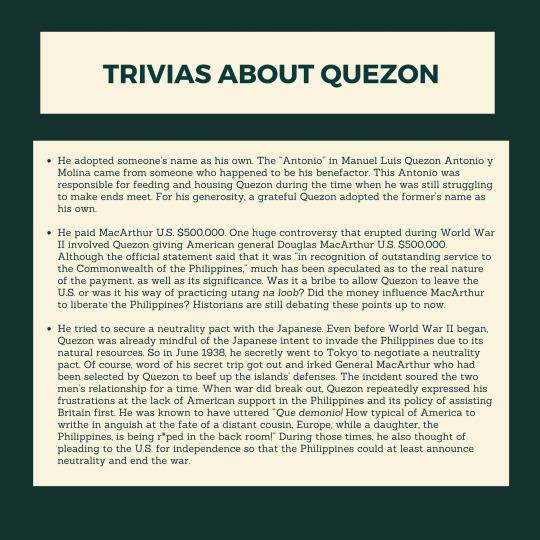
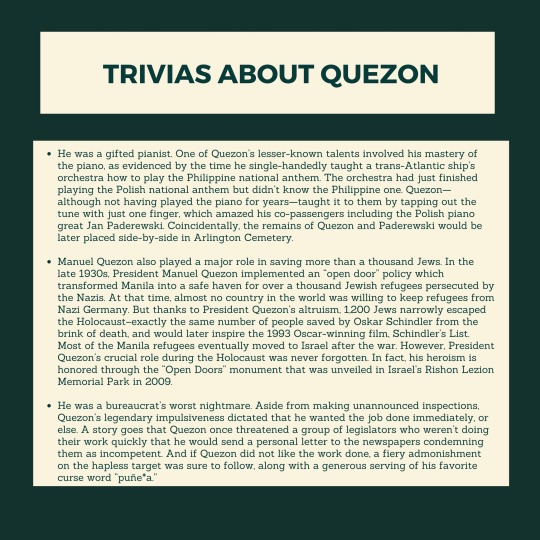
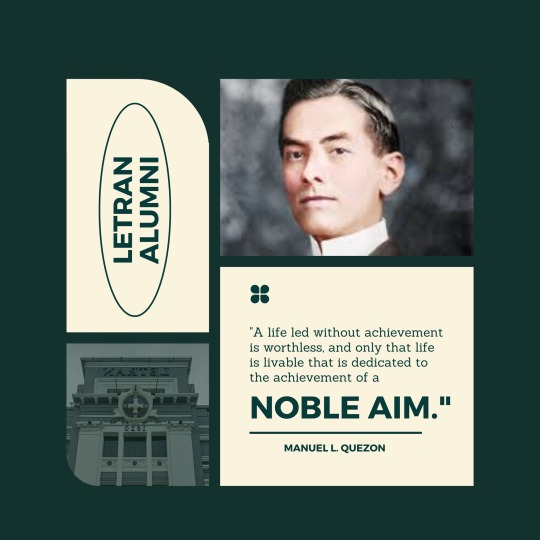
Quezon left Baler in 1888 to attend Colegio de San Juan de Letran in Manila, where he graduated in 1894. He had his law degree from the University of Santo Tomas and was certified to the bar in 1903. He rose through the ranks of his native province's government to become its fiscal chief, and he was shortly elected governor. He ran for the Philippine Assembly as a member of the Nacionalista Party, won by a massive margin, and became a former senate leader in the 1907 elections. He was chosen Resident Commissioner to Washington, D.C. in 1909, a position he maintained until 1916. His most notable accomplishment was the passing of the Jones Act, which provided for the independence of the Philippines. In 1916, he was elected as Senate President. He led the first Independence Mission to the United States Congress, bringing back the Tydings-McDuffie Independence Act in 1934. After a spectacular performance as the First Senate President, the "Star of Baler" shone as the Commonwealth's First President. He was resolute in his aim to free the masses from the constraints of colonialism, which fueled his attempts to win his country's independence. This approach resulted in the creation of political stability within the framework of the 1935 Constitution, the implementation of measures to protect the people's actual well- being, and the adaptation of the national economy to the troubles of free national identity. He was a vibrant Filipino leader and a real friend of the poor and oppressed, for whom he cared deeply. He died at Saranac Lake, New York on August 1, 1944. Quezon was a clever and fearless guy, a sharp and resourceful politician who was impetuous, generous, and strong-willed. Though egotistical, his passion for his nation exceeded his love for himself. He became a symbol of independence and Philippine nationalism for his people. The slogan "social justice" defined his administration of the Philippine Commonwealth. He implemented several changes and pushed for improved living and working circumstances for his people. He and his government were successful in several of these. Despite living during the most volatile period in Philippine history, when the peasantry—75 percent of the population—was rising against social injustice and age-old exploitation, Quezon failed to implement long-term changes in land tenancy, salaries, income distribution, and other areas of crisis. Quezon, a politician who was both delicate and bullheaded, supple and obsessive, served primarily the interests of the Filipino elite, or ruling oligarchy (approximately 200 families), who owned and managed lands and companies. Senator Claro M. Recto, a contemporary, made the fairest and astute assessment when he defined Quezon as "a successful politician...due to his mastery of political intrigue. He understood how to forge deep and loyal friendships even among political opponents, but he also knew how to incite envy, mistrust, ambition, and jealously even among his devoted supporters."
References:
Official Calendar Of The Republic : Presidential Communications Development and Strategic Planning Office (PCDSPO) : Free Download, Borrow, and Streaming : (n.d.). Internet Archive. Retrieved September 26, 2021, from https://archive.org/details/official-calendar-of-the-republic
Presidents Of The Philippines. (n.d.). AT&T Uverse. Retrieved September 26, 2021, from http://informnhelp.blogspot.com/2012/03/presidents-of-philippines.html
What Was the Independence Act? | AHA. (n.d.). American Historical Association. Retrieved September 26, 2021, from https://www.historians.org/about-aha-and-membership/aha-history-and- archives/gi-roundtable-series/pamphlets/em-24-what-lies-ahead-for-the-philippines-(1945)/what- was-the-independence-act
Senators Profile - Manuel L. Quezon. (n.d.). Wayback Machine. Retrieved September 26, 2021, from http://web.archive.org/web/20210819031559/http://legacy.senate.gov.ph/senators/former_senator s/manuel_quezon.htm
#ColegiodeSanJuandeLetran #LetranAlumni #NotableLetranAlumniThroughoutTheYears #Arriba #Letranite #ManuelQuezon
0 notes